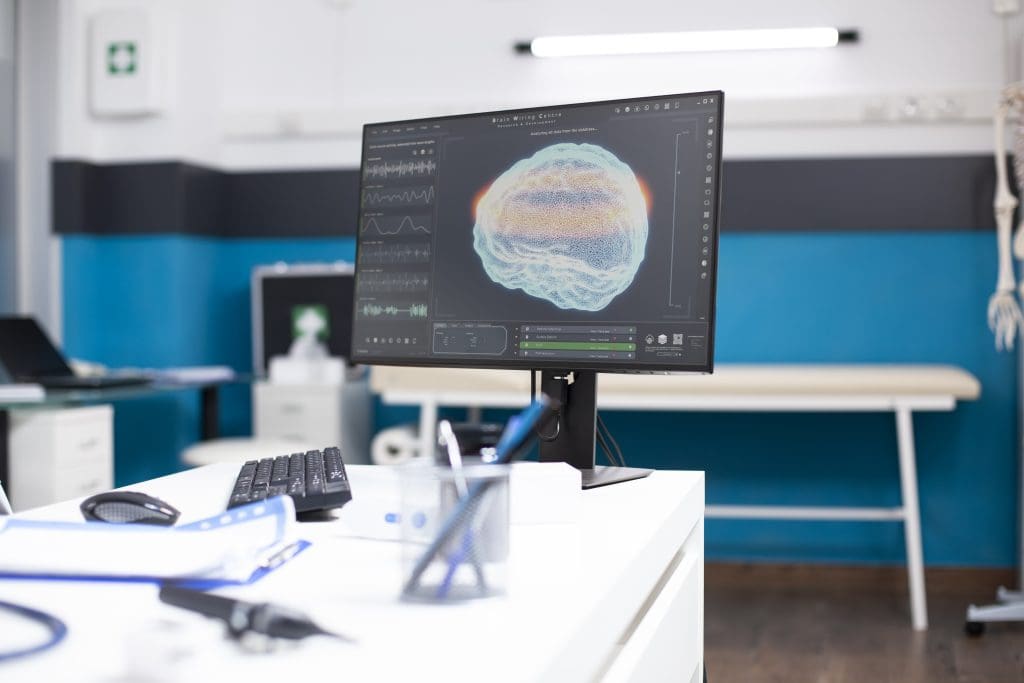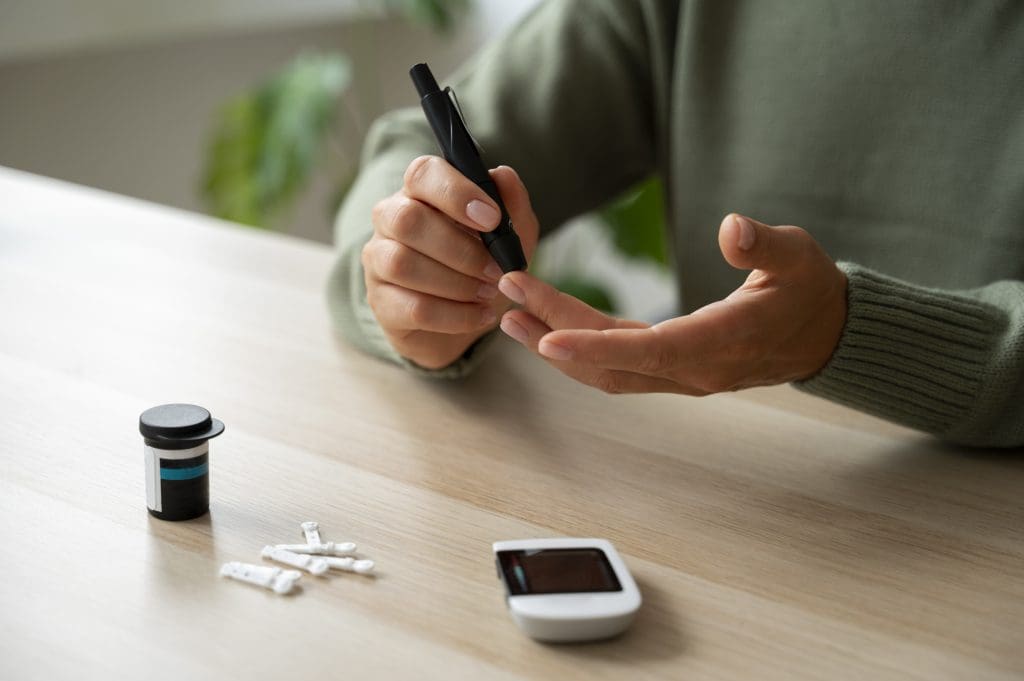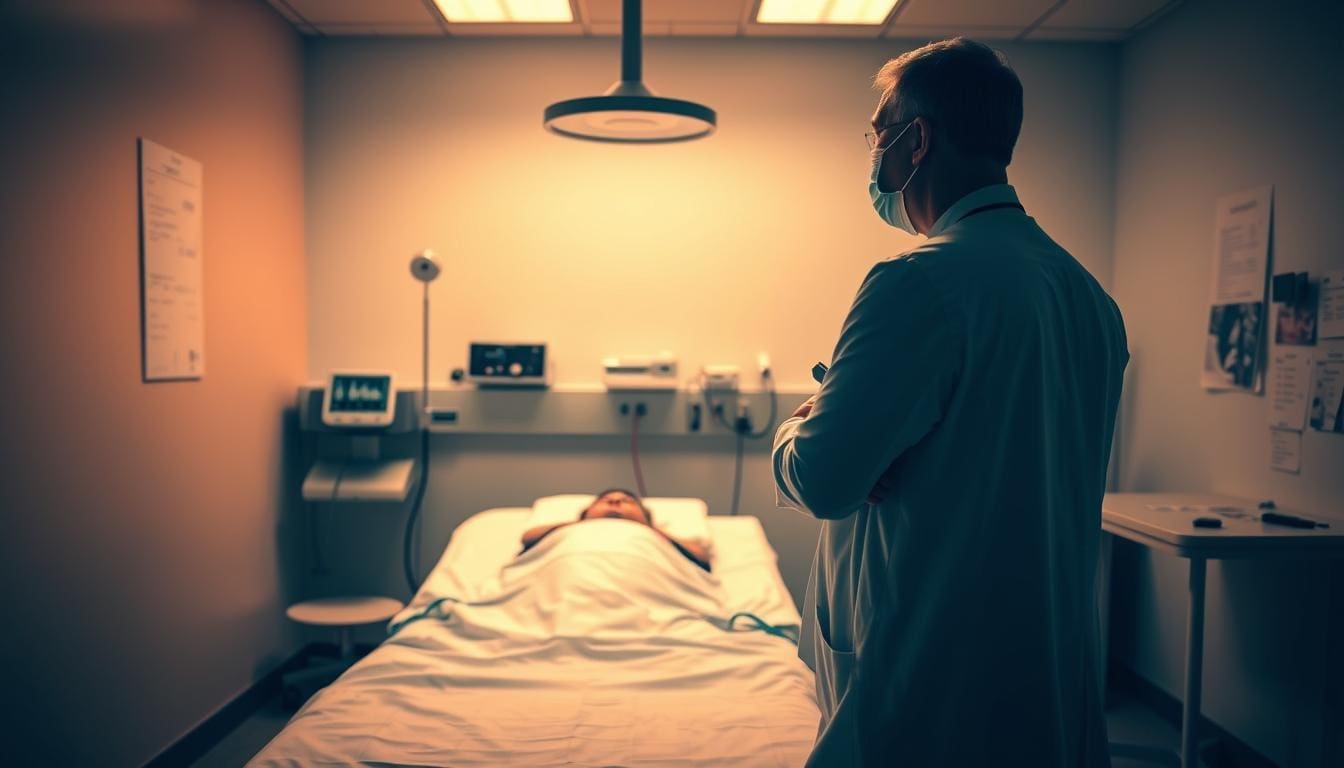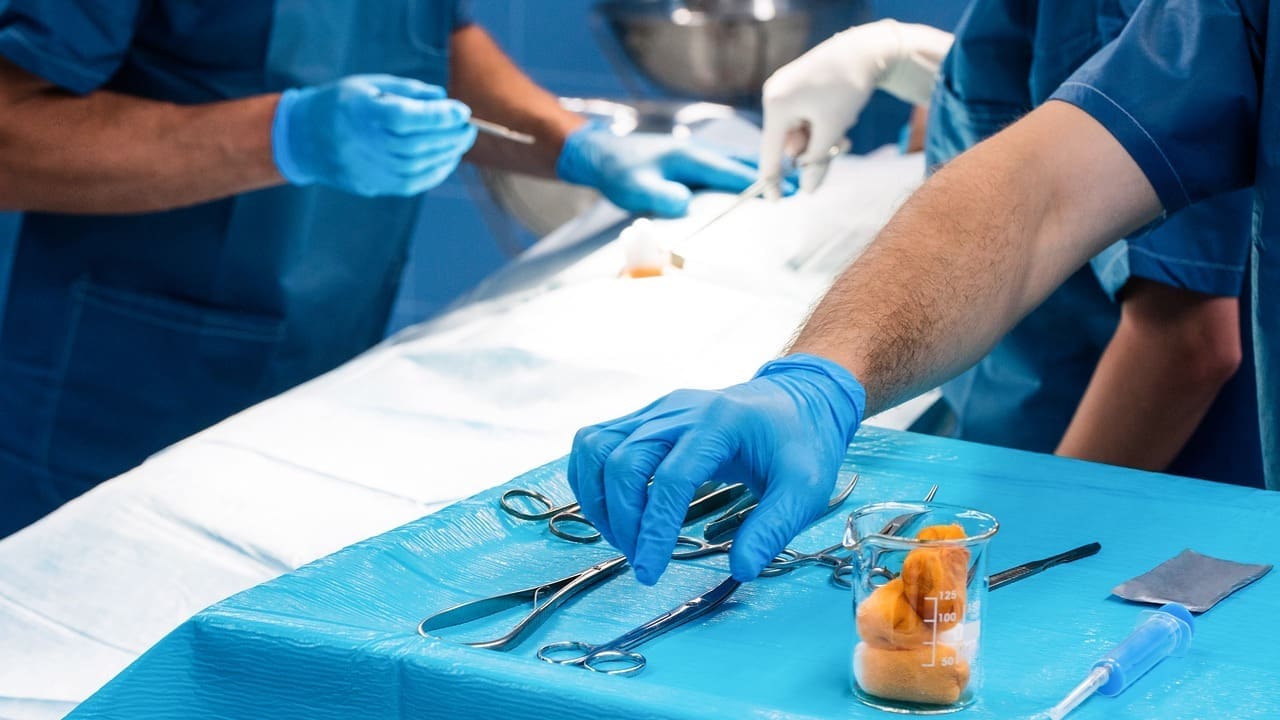Last Updated on November 27, 2025 by Bilal Hasdemir
After a Positron Emission Tomography (PET) scan, many patients wonder about their results. They are concerned, mainly about finding small tumors.
Understanding PET scan results is key for patients to feel informed and in charge of their health. We will cover common concerns and questions after a PET scan. We’ll also talk about what to expect and managing side effects.
Key Takeaways
- Understand the limitations of PET scans in detecting small tumors.
- Learn how to manage side effects after a PET scan.
- Get an overview of what to expect after undergoing a PET scan.
- Discover the importance of understanding PET scan results.
- Find out how to feel informed and in control of your health after a PET scan.
Understanding what a PET scan is

A PET scan, or Positron Emission Tomography, is a cutting-edge medical imaging method. It gives us deep insights into the body’s inner workings. We use PET scans to find and track different health issues, like cancer, brain disorders, and heart diseases.
Definition and basic principles
A PET scan is a nuclear medicine imaging technique. It involves injecting a small amount of radioactive tracer into the body. This tracer goes to areas with lots of activity, like growing cancer cells.
The PET scanner picks up signals from the tracer. It creates detailed images of the body’s inner structures and how they work.
How PET scans differ from other imaging tests
PET scans are different from CT scans or MRI. CT scans show detailed body structures, but PET scans look at metabolic activity. This makes PET scans great for finding cancer, checking brain health, and looking at heart health.
| Imaging Modality | Primary Use | Key Benefits |
| PET Scan | Cancer detection, neurological assessment, cardiovascular evaluation | Metabolic activity visualization, high sensitivity for detecting abnormalities |
| CT Scan | Anatomical imaging, trauma assessment, cancer staging | High-resolution anatomical images, quick procedure |
| MRI | Soft tissue imaging, neurological assessment, musculoskeletal evaluation | Excellent soft tissue contrast, non-invasive |
How does a PET scan work?

Learning about PET scans can make patients feel less nervous. We’ll explore the science behind them. This includes how radioactive tracers work and their role in diagnosing health issues.
The science behind positron emission tomography
Positron Emission Tomography (PET) is a cutting-edge imaging method. It shows how the body’s cells work. We use a tiny amount of radioactive tracer, often linked to glucose, to spot active areas.

This tracer sends out positrons, which meet electrons and create gamma rays. The PET scanner picks up these rays. It makes detailed images of the body’s inner workings. These images help doctors spot diseases early and check if treatments are working.
The PET scanner captures the gamma rays from the tracer. It uses this info to build detailed, three-dimensional pictures of the body. This tech helps find diseases early and see how well treatments are doing.
The role of radioactive tracers in your body
The radioactive tracer in PET scans is key to finding what’s going on inside you. It’s injected into your blood and goes to active areas, like growing tumors. The most common tracer is Fluorodeoxyglucose (FDG), a glucose molecule with a radioactive atom.
As the tracer breaks down, it sends out positrons. These are caught by the PET scanner. This lets doctors see where the body is most active. It helps them diagnose and keep an eye on different health issues.
Some important facts about radioactive tracers are:
- They are safe and leave the body in a few hours.
- The amount used is tiny, so there’s little risk of harm.
- The tracer is linked to a natural body molecule, like glucose.
Common reasons for getting a PET scan
PET scans are key in diagnosing many health issues. They help doctors see how the body works. This is important for finding and treating diseases.
Cancer detection and monitoring

PET scans are mainly used for cancer. They help find cancer, see how far it has spread, and check if treatments are working. This info is vital for planning the best care.
Studies show PET scans make cancer diagnosis more accurate. This leads to better care for patients.
Neurological conditions assessment
PET scans are also used for brain health. They check brain activity and find problems. This helps in diagnosing and treating conditions like Alzheimer’s.
- Early detection of neurological disorders
- Monitoring disease progression
- Assessing treatment efficacy
Cardiovascular health evaluation
PET scans help with heart health too. They look at how well the heart works and find damaged areas. This helps in treating heart disease.
Using PET scans for heart health improves treatment plans. It helps in better patient care.
Preparing for your PET scan
Getting ready for a PET scan is key to a smooth process and accurate results. We know medical scans can be stressful. Being prepared can help ease that stress.
Dietary Restrictions Before the Procedure

You might need to follow special diets before your PET scan. These rules depend on the scan type. You’ll likely be told to avoid sugary foods and drinks. Following these rules is vital for accurate results. Your doctor will tell you exactly what to eat and what to avoid.
Medication Considerations and Adjustments
Some medications might need to be changed or stopped before your scan. Tell your doctor about all your meds, including supplements and vitamins. They’ll tell you if any changes are needed. This is important for your safety during the scan.
What to Wear and Bring on Scan Day
On scan day, wear comfy clothes without metal. No jewelry or clothes with metal parts. Also, leave all electronic devices and other items behind. Remember to bring your insurance card and ID to the scan facility.
| Preparation Step | Description |
| Dietary Restrictions | Avoid sugary foods and drinks as instructed by your healthcare provider. |
| Medication Adjustments | Inform your healthcare provider about all medications and follow their advice. |
| Clothing and Items to Bring | Wear comfortable, metal-free clothing and bring required documents. |
The PET scan procedure step by step
We’ll walk you through the PET scan process, from start to finish. Knowing each step can make the experience smoother.
Before entering the scanner room
You’ll wait in a special area before the scan starts. This lets the radioactive tracer spread through your body. You might need to take off metal items or jewelry to avoid scan interference.
It’s key to listen to the medical staff’s instructions for a successful scan.
During the scan: what happens
In the scanner room, you’ll lie on a table that moves into the PET scanner. The machine will circle around you, taking pictures of the tracer in your body. You’ll need to stay very quiet and might be asked to hold your breath briefly.
Immediately after the scan is complete
After the scan, you can usually go back to your day unless told differently by your doctor. The team will watch you for a bit to check for any bad reactions to the tracer.
“The PET scan procedure is generally well-tolerated by most patients,” says Dr. Jane Smith, a leading nuclear medicine specialist. “By understanding what to expect, patients can feel more at ease during the process.”
How long does a PET scan take?
Knowing how long a PET scan takes is important. It helps patients get ready mentally and physically. We’ll explain how long a PET scan usually lasts and what can affect this time.
Duration of Different Types of PET Scans
The time for a PET scan varies based on the type and your health needs. A PET scan can last from 30 minutes to several hours. For example, a PET/CT scan, which combines two scans, usually takes 30 minutes to an hour.
Here’s a quick look at the typical time for different PET scans:
| Type of PET Scan | Typical Duration |
| PET/CT Scan | 30-60 minutes |
| PET/MRI Scan | 60-90 minutes |
| Whole-Body PET Scan | 60-120 minutes |
Factors That May Extend Your Scan Time
Several things can make your PET scan longer. These include how complex your condition is, if you need extra images, or if it’s your first scan. Your body size, the area being scanned, and how well you can stay calm also play a role.
It’s key to listen to your doctor’s advice and share any worries. This ensures your PET scan goes smoothly and is done right.
Normal physical sensations during a PET scan
Knowing what to expect during a PET scan can ease your worries. We aim to make your experience as comfortable and informed as possible. This way, you can feel at ease during the diagnostic process.
What You Might Feel When the Tracer is Injected
When the tracer is injected, you might feel a pinch or stinging at the needle site. This is usually minor and short-lived. Some people might feel a cold sensation in their arm as the tracer moves through their blood. This feeling is brief and safe.
Sensations While in the Scanner
While in the scanner, you’ll lie on a comfortable table that slides into the machine. Inside, you might hear sounds like whirring or clicking. These are just the machine’s normal noises.
It’s important to stay very quiet and not move during the scan. You might be asked to hold your breath for a bit. The scan itself is painless, and many find it relaxing. They know it’s a key step towards getting a diagnosis or treatment plan.
We know PET scans can make people anxious. Knowing what to expect can help you feel more at ease. Our team is here to support and care for you every step of the way.
What to expect immediately after your PET scan
Wondering what happens after a PET scan? We’ll walk you through the common feelings and aftercare tips. Right after your scan, you’ll be watched for any quick reactions to the tracer.
Common physical sensations in the first hours
Right after your PET scan, you might feel tired or dizzy. You could also have a mild reaction at the injection site. Most people can go back to normal activities soon after. But, drinking lots of water helps get rid of the tracer.
Doctors say, “patients should be aware of the possible mild side effects and know how to handle them.”
“Staying hydrated is key to helping your body recover from the PET scan procedure.”
Normal vs. concerning immediate reactions
Most reactions to the PET scan are mild and short-lived. Normal feelings include being a bit tired or tasting something metallic from the tracer. But, if you have severe symptoms like trouble breathing, a fast heartbeat, or severe pain, get help right away.
- Drink plenty of water to help eliminate the tracer.
- Rest if you’re feeling tired.
- Monitor your body’s reaction and report any severe symptoms to your healthcare provider.
Initial aftercare instructions
Your doctor will tell you how to take care of yourself after the scan. You’ll likely be told to avoid close contact with pregnant women and young kids for a few hours. Following these guidelines keeps you and others safe.
Knowing what to expect after your PET scan helps you prepare for the recovery period. It makes sure you have a smooth recovery.
PET scan side effects you might experience
Knowing about PET scan side effects can help you prepare. PET scans are useful for diagnosing, but it’s good to know about possible reactions.
Common short-term side effects
Most people do well with PET scans, but some might feel a bit uncomfortable. You might experience:
- Discomfort or pain at the injection site
- Mild allergic reactions to the radioactive tracer
- Temporary changes in heart rate or blood pressure
These issues are usually mild and go away soon after the scan.
Less common reactions and discomforts
Some people might face less common issues, like:
- Fatigue or feeling tired
- Nausea or dizziness
- Headache
A study found a small number of patients reported these symptoms. They usually get better in a few hours.
“I felt a bit dizzy after my PET scan, but it passed quickly. The staff were very reassuring and helped me feel better.”
A patient sharing their experience
Rare but serious adverse reactions
Though rare, serious side effects can happen. These include:
- Severe allergic reactions to the tracer
- Significant changes in heart rhythm
It’s key to listen to your doctor and report any odd symptoms right away.
We stress the need to talk about any worries or health history with your doctor before a PET scan. This can help lower risks.
Recovery time after a PET scan
After a PET scan, knowing how long it takes to recover is key. The recovery time is usually short. But knowing what to expect can make you feel better and recover faster.
What to expect in the first 24 hours
In the first 24 hours, you might feel a bit tired or dizzy. This is because of the radioactive tracer used in the scan. You might also feel a bit nauseous.
- Fatigue or feeling tired
- Dizziness or lightheadedness
- Nausea
These feelings usually go away quickly. It’s best to rest and not do too much during this time.
When you can resume normal activities
You can usually go back to your normal activities in 24 to 48 hours. But, always listen to what your doctor says. They might give you different advice based on your health and the scan you had.
Key considerations for resuming activities:
- Wait for your healthcare provider’s approval before engaging in strenuous exercise or activities.
- Gradually return to your normal routine to avoid exhaustion.
Hydration and aftercare recommendations
Drinking lots of water is important after a PET scan. It helps get rid of the radioactive tracer. We suggest:
- Drinking plenty of water
- Avoiding caffeine and alcohol, which can act as diuretics
- Eating a balanced diet to support your overall health
By following these tips, you can recover comfortably and effectively from your PET scan.
Managing discomfort after your PET scan
We know the time after a PET scan can be tough. It’s important to know how to handle any discomfort. After a PET scan, you might feel different because of the tracer used.
Home Remedies for Common Post-Scan Symptoms
Most discomfort after a PET scan goes away quickly with simple steps. Staying hydrated is key to getting rid of the tracer. Drinking lots of water and other fluids can help avoid side effects. Also, resting and not doing too much for the rest of the day helps your body heal.
Some people might see redness or swelling where the tracer was given. A cold compress can help with this. It’s also good to watch your body temperature and tell your doctor if you get a fever.
| Symptom | Home Remedy |
| Fatigue | Rest and hydration |
| Injection site reaction | Cold compress |
| Nausea | Light meal, hydration |
When to Contact Your Healthcare Provider
Most discomfort after a PET scan is mild and short-lived. But, there are times when you should call your doctor. If you have severe symptoms like trouble breathing, a fast heartbeat, or a bad rash, call your doctor right away.
Also, if you see signs of infection at the injection site, like more redness, swelling, or pain, reach out to your healthcare team. Watching your symptoms and knowing when to get help is important for your care.
By following these tips and paying attention to how your body reacts, you can handle any discomfort well. This helps you recover smoothly.
Radiation exposure from PET scans
PET scans use small amounts of radioactive tracers. This raises questions about safety. It’s natural to worry about radiation exposure, but understanding the facts can help ease these concerns.
Understanding radiation doses and safety
The radiation from a PET scan is low. The tracer used decays quickly, reducing exposure time. Typically, the dose is similar to or a bit more than a CT scan’s. Our team ensures safe administration and follows strict protocols.
Putting the risks in context
PET scans involve radiation, but the benefits often outweigh the risks. The risk of radiation exposure is generally low. We compare it to other medical procedures to understand the risks better.
Research on PET scan radiation is ongoing. Our team keeps up with the latest to provide the best care.
Comparing patient experiences: PET scan vs. CT scan
Patients often compare PET scans and CT scans for diagnostic imaging. Both are important tools, but they work differently and have unique procedures.
Procedural differences between the scans
PET scans use a radioactive tracer to see how the body works. They help find cancer, neurological issues, and heart problems. CT scans, on the other hand, use X-rays to show the body’s inside. They help find injuries, cancers, and blood vessel diseases.
PET scans need a radioactive tracer that the body absorbs. The scan then shows where this tracer is, giving clues about body functions. CT scans don’t need a tracer and just use X-rays to make images.
Post-procedure recovery comparison
Recovery after a PET scan and a CT scan can differ. After a PET scan, patients might feel tired or slightly radioactive for a bit. But these feelings don’t last long.
CT scans usually don’t cause any after-effects unless a dye was used. Then, some might feel sick or have an allergic reaction. But this is rare.
Both PET and CT scans are safe and don’t keep you down for long. Knowing how they differ helps patients get ready for their tests.
Getting your PET scan results
Getting your PET scan results is a big moment in your health journey. We know waiting can be stressful. But we’re here to help you know what to expect.
Typical timeframe for receiving results
The time it takes to get your PET scan results varies. It depends on the place and how complex your scan was. Usually, you’ll get your results in 24 to 48 hours. Sometimes, it might take longer. Always ask your doctor about their specific time frame when you book your scan.
Understanding your scan report
Your PET scan report is detailed. It shows where the tracer went in your body and any concerns. It’s best to go over it with your doctor. They can explain what it means for your treatment.
As one expert says, “Knowing your PET scan results is key to making good care choices.” The clearness of the report helps you feel more confident about your care.
“The PET scan report provides a wealth of information that, when interpreted correctly, can be invaluable in guiding patient care.”
Follow-up appointments and next steps
After getting your results, your doctor will want to talk about them. This is your chance to ask questions and understand what’s next. We suggest making a list of questions to get the most out of this meeting. Being active in your care can really help your health.
Special considerations for specific patient groups
We know that certain groups, like pregnant women and those with chronic conditions, have unique needs for PET scans. It’s important to meet these needs to keep patients safe and ensure accurate scan results.
Pregnant or breastfeeding women
Pregnant or breastfeeding women face a big decision about PET scans. The main worry is radiation’s effect on the fetus or baby. We tell pregnant women to tell their doctor about their pregnancy before the scan.

In some cases, other imaging methods might be better. If a PET scan is needed, we do our best to reduce radiation while getting the needed info. Women who are breastfeeding might need to stop for a while after the scan because the tracer can get into breast milk.
Diabetic patients

Diabetic patients need special care with PET scans, like adjusting their meds or fasting. We might ask them to change their medication or fasting plans before the scan. This helps get accurate results.
It’s key for diabetic patients to talk to their doctor about their diabetes and meds.
Patients with claustrophobia or anxiety
Patients with claustrophobia or anxiety can make their PET scan experience better. We suggest talking to your doctor about your worries before the scan. Sometimes, we offer mild sedation to help you relax.
The PET scan machine is open at both ends, which might feel less tight than other imaging tools. But for those with severe claustrophobia, we look for other ways to make the scan as stress-free as possible.
| Patient Group | Special Considerations |
| Pregnant or Breastfeeding Women | Risk assessment, alternative imaging, temporary cessation of breastfeeding |
| Diabetic Patients | Medication adjustment, fasting regimen |
| Patients with Claustrophobia or Anxiety | Sedation, open PET scan machine, pre-scan counseling |
By understanding and addressing these special considerations, we can ensure that all patients receive the best possible care during their PET scan procedure.
Conclusion
Understanding PET scans is key for those going through this test. We’ve looked into PET scans, from their basics to the steps involved. We’ve also seen why they’re important in medical checks.
We talked about how PET scans are different from other tests. They play a big role in finding cancer, checking the brain, and heart health. We shared tips on getting ready, what happens during and after, and possible side effects.
Knowing about PET scans helps patients understand their diagnostic path better. We hope this detailed look has given you useful insights. It’s our aim to help you make smart choices about your health.
FAQ
What is a PET scan?
A PET (Positron Emission Tomography) scan is a test that uses a radioactive tracer. It helps see how the body works, like when it’s sick. It’s used for many health issues, like cancer and heart problems.
How long does a PET scan take?
A PET scan can take anywhere from 30 minutes to several hours. This depends on the type of scan and what it needs to do.
What are the common side effects of a PET scan?
After a PET scan, you might feel a little sick. This could be a headache, dizziness, or nausea. These feelings usually go away quickly.
How do I prepare for a PET scan?
To get ready for a PET scan, you might need to eat certain foods or tell your doctor about your meds. Also, don’t do too much before the scan.
What should I expect during a PET scan?
During a PET scan, you’ll get a special dye that glows. Then, you’ll lie on a table that moves into a big machine. It’s not painful, but you might feel a bit uncomfortable because you have to stay very quiet.
How long does it take to get PET scan results?
You’ll usually get your PET scan results a few days to a week after. It depends on how fast the lab can read them.
Are PET scans safe?
PET scans are mostly safe. They do use a little bit of radiation. Your doctor will talk to you about the good and bad parts.
Can I undergo a PET scan if I’m pregnant or breastfeeding?
A PET scan looks at how your body works, while a CT scan shows what your body looks like. They can both be used together to understand your health better.
How does a PET scan differ from a CT scan?
A PET scan looks at how your body works, while a CT scan shows what your body looks like. They can both be used together to understand your health better.
What are PET scans used for?
PET scans help find and watch many health problems. This includes cancer, brain issues, and heart disease. They show how your body is working.
Can I resume normal activities after a PET scan?
Yes, you can go back to your usual activities after a PET scan. Just drink lots of water and follow what your doctor says.
How do I manage discomfort after a PET scan?
If you’re feeling sore after a PET scan, try drinking water, resting, and taking pain meds if your doctor says it’s okay.
What is a PET scan?
A PET (Positron Emission Tomography) scan is a test that uses a radioactive tracer. It helps see how the body works, like when it’s sick. It’s used for many health issues, like cancer and heart problems.
How long does a PET scan take?
A PET scan can take anywhere from 30 minutes to several hours. This depends on the type of scan and what it needs to do.
What are the common side effects of a PET scan?
After a PET scan, you might feel a little sick. This could be a headache, dizziness, or nausea. These feelings usually go away quickly.
How do I prepare for a PET scan?
To get ready for a PET scan, you might need to eat certain foods or tell your doctor about your meds. Also, don’t do too much before the scan.
What should I expect during a PET scan?
During a PET scan, you’ll get a special dye that glows. Then, you’ll lie on a table that moves into a big machine. It’s not painful, but you might feel a bit uncomfortable because you have to stay very quiet.
How long does it take to get PET scan results?
You’ll usually get your PET scan results a few days to a week after. It depends on how fast the lab can read them.
Are PET scans safe?
PET scans are mostly safe. They do use a little bit of radiation. Your doctor will talk to you about the good and bad parts.
Can I undergo a PET scan if I’m pregnant or breastfeeding?
If you’re expecting or nursing, tell your doctor first. PET scans use radiation, which might not be safe for your baby.
How does a PET scan differ from a CT scan?
A PET scan looks at how your body works, while a CT scan shows what your body looks like. They can both be used together to understand your health better.
What are PET scans used for?
PET scans help find and watch many health problems. This includes cancer, brain issues, and heart disease. They show how your body is working.
Can I resume normal activities after a PET scan?
Yes, you can go back to your usual activities after a PET scan. Just drink lots of water and follow what your doctor says.
How do I manage discomfort after a PET scan?
If you’re feeling sore after a PET scan, try drinking water, resting, and taking pain meds if your doctor says it’s okay.






